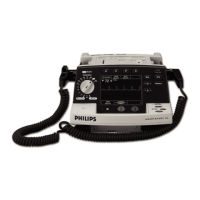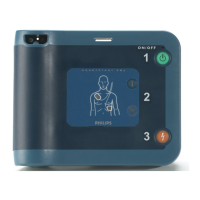Performance Verification Procedures 5: Performance Verification
161
Check the Device
1 Inspect the device on all sides, looking for:
• Signs of mechanical damage to the case, controls, display, or printer.
• Loose or missing hardware.
• Evidence of liquid spill, mechanical damage, pin corrosion, or debris:
– Open the printer door and clean out any accumulation using gloves and an approved
cleaner.
– Inspect the battery connector using a flashlight.
– Check for residue in the patient connectors on either side of the device (ECG, SpO
2
, NBP,
Therapy port, USB port, ECG Out, network port, AC mains socket).
• Residue on the thermal printhead.
• Printer roller wear.
2 Inspect the paddles, power cord, battery, cables, and sensors for signs of the following:
• Wear or damage to paddles, cables, and adapters.
• Wear or damage to patient cables and associated strain reliefs.
• Wear or damage to power cord and associated strain relief.
PASS: Only normal wear, no damage serious enough to inhibit performance. No corrosion visible.
Service Mode Tests
The following tests are available from Service Mode:
Operational Check . . . . . . . . . . . . . . . . . p. 161
Battery test is a part of the battery calibration procedure, see “Battery Calibration” on page 16.
Printer Test . . . . . . . . . . . . . . . . . . . p. 164
Controls Test . . . . . . . . . . . . . . . . . . p. 162
Display Test . . . . . . . . . . . . . . . . . . p. 163
Fan Test . . . . . . . . . . . . . . . . . . . p. 164
USB Test . . . . . . . . . . . . . . . . . . . p. 165
Service Mode also allows you to view and print the Error Logs (see “Error Log Messages” on page 41);
check and enter device information, such as serial number and options (see “Device Information” on
page 10); and upgrade the software and set the device’s language (see “Software Upgrades” on page 11).
CAUTION: Be sure that the defibrillator/monitor is not connected to a patient when performing any functions in
Service Mode.
Operational Check
Operational Check (Op Check) should be performed at regular intervals to supplement the hourly, daily,
and weekly Automated Tests executed by the HeartStart XL+. Automated Tests provide adequate
assurance that the device is in a functional state of readiness. Op Check supplements the Automated
Tests by verifying therapy cables, the ECG cable, paddles, and audio functionality, along with replicating
the Weekly test. Op Check also notifies you if the battery or NBP module need calibration.
Always run an Op Check and check the Error Logs after a repair.

